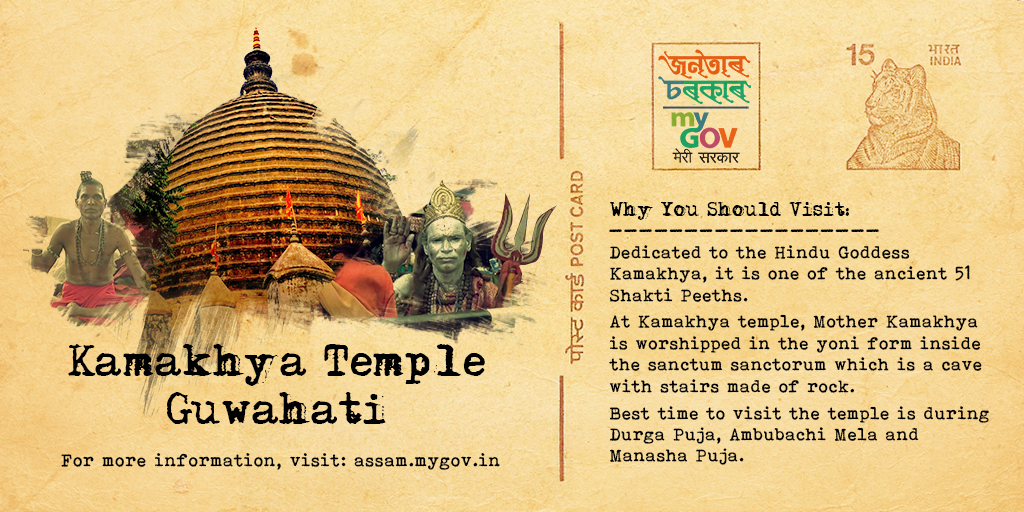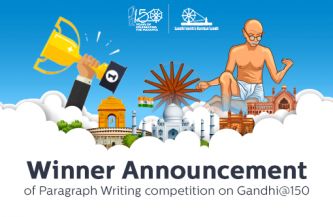Assam the rising star from East on the tourism Map of India
Tourism is important because it gives economic opportunities to the poorest of the poor.
– PM Narendra Modi

Assam Govt has imbibed Prime Minister’s Modi’s vision of tourism as a catalyst to development in state. To realise the dream, state Government is running focussed, time-bound programmes to yiled better results.
MyGov Assam will bring in series of blogs entailing various torusims hotspots of state.
Govt of Assam recently declared Kamakhya Temple as a Swachh Iconic Place. Adding to this, the state Govt along with temple management is taking various steps to transform it into the cleanest pilgrimage site of the country. Moreover, under the PRASAD scheme, Kamakhya has been included in the thirteen sites identified for development by the Central Ministry of Tourism.

Toursim Spot 1: Kamakhya Temple, Guwahati
Nestled atop the lush green Nilachal Hill, in the western part of Guwahati, Kamakhya Temple is one of the ancient 51 Shakti Peeths in the world. The most popular pilgrimage hotspot of the region, it is a Hindu temple dedicated to Goddess Kamakhya.
Kamakhya Temple is the oldest living shrine of Kamarupa (ancient Assam) and is closely connected to various stages of the history of the land.
The uniqueness about Kamakhya Temple is that there is no idol of the Goddess Shakti in the temple. Instead, a symbol of yoni (female genital organ) located in the corner of a cave within the temple is the main object of worship. The yoni remains moist by a natural spring which flows from the crevice in the bedrock of the cave.
Besides the daily puja offered to the deity, some of the major devotional festivals held on the premises of Kamakhya temple are Durga Puja and Ambubachi Mela.
Legend behind Kamakhya: Sati had married Lord Shiva against her father King Daksha’s wish. Once during a yajna, King Daksha insulted Lord Shiva. Sati unable to bear the disrespect shown to her husband, jumped in the yajna fire and killed herself. Devastated and enraged, Shiva carried the lifeless body of Sati in his arms and started the dance of destruction of the universe. In order to save the universe from destruction, Lord Vishnu cut the body of Sati into several pieces with his Sudarshan Chakra. As a result, various parts of Sati fell in different places and these places came to be known as Shakti Peeths. The yoni of Sati fell at Kamakhya and became a sacred place of worship.
For more information, visit: http://kamakhyatourism.com

Toursim Spot 2: Umananda Island, Guwahati
Situated in the heart of the river Brahmaputra, Umananda is the smallest inhabited river island in the world. Also known as the Peacock Island for its shape and Bhasmachal for a myth associated with Lord Shiva, there is a temple dedicated to Lord Shiva in the island.
According to myths, Lord Shiva created the island for the happiness and pleasure of his beloved wife Parvati. Lord Shiva is said to dwell here in the form of Bhayananda. Once when Kamadev (God of love) interrupted Lord Shiva’s deep meditation, he burnt Kamdev to ashes with his third eye on Umananda. As such, the island got its alternative name Bhasmachal.

Built by the the Ahom King Gadadhar Singha, Umananda temple is regularly visited by many devotees and daily ferry services are available to this place. The best time to visit Umananda is during Mahashivaratri which is the annual Hindu festival celebrated in honour of Lord Shiva.
At present, Government of Assam is planning to boost the tourism potential in Umananda and draw in tourists from far across the world.
For more information visit: tourismcorporation.assam.gov.in





